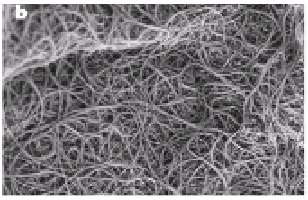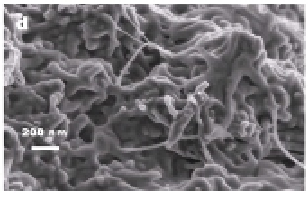Biomedical Engineering Reference
In-Depth Information
a
b
b
c
+
NH
2
P
NH
H
C
C
C
C
Figure 3.5
SEM images and schematic representation of SWNTs
modification: (a) purified SWNTs, (b) SWNTs modified with PANI (after 300
cycles), and (c) possible mechanism of polymerization. Note: The images
were changed with respect to the original use of pictures in the publication.
Reprinted
, Wei, D., Kvarnström, C.,
Lindfors, T., and Ivaska, A., Electrochemical functionalization of single
walled carbon nanotubes with polyaniline in ionic liquids, 206-210,
Copyright (2007), with permission from Elsevier.
from
Electrochem.
Commun
.,
9
Wei et al. synthesized PANI-gold composite (PANI:Au)
nanoparticles in ionic liquid media for a nonvolatile memory
device [80]. The PANI:Au particles were synthesized by cyclic
voltammetry in [EMIM][Tos] (tosylate) under acidic conditions. The
resulting composite could directly be electrodeposited on modified
ITO substrate to construct an active layer in the memory device,
simplifying, therefore, the processing procedure considerably. The
device was found to be stable in air, and it exhibited bistability
and negative differential resistance. Reproducibility of these two
parameters is of great importance in organic electronics. The
obtained PANI:Au single-layer device was tested after 8 weeks and
the device still exhibited sufficient current-voltage characteristics.
Pringle et al. used [MEIM][Tf
N] (1-methyl-3-ethylimidazolium)
in chemical synthesis of PPy and PTh. Different chemical oxidants
(gold chloride, Fe tosylate, silver nitrate, and Fe(ClO
2
) were used
as dopants [81]. It was found that gold chloride suits best for
fabrication of conducting polymer nanoparticles. The size of PTh and
)
4
3









































Search WWH ::

Custom Search